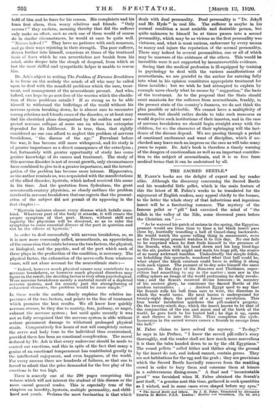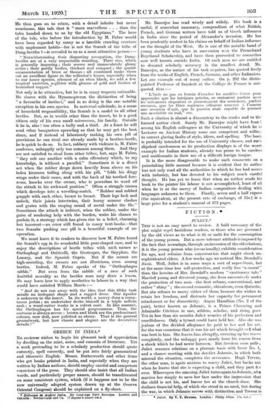THE SACRED BEETLE.* M. FABRE'S books are the delight of
expert and lay reader alike. Although the discovery concerning the Sacred Beetle and his wonderful little pellet, which is the main feature of this the latest of M. Fabre's works to be translated for the enjoyment of English readers, may appeal chiefly to the former, to the latter the whole story of that industrious and ingenious insect will be a fascinating romance. The mystery of the famous pellet or " pill " had exercised the mind of " the fellah in the valley of the Nile, some thousand years before the Christian era " :— " As he watered his patch of onions in the spring, the Egyptian peasant would see from time to time a fat black insect pass close by, hurriedly trundling a ball of Camel-dung backwards. He would watch the queer rolling thing in amazement, even as the Provençal peasant watches it to this day. No one fails to be surprised when he first finds himself in the presence of the Scarab, who, with his head down and his long hind-legs in the air, pushes with might and main his huge pill, the source of so many awkward tumbles. Undoubtedly the simple fellah, on beholding this spectacle, wondered what that ball could be, what object the black creature could have in rolling it along with such vigour. The peasant of to-day asks himself the same question. In the days of the Rameses and Thothmes, super- stition had something to say in the matter ; men saw in the rolling sphere an image of the world performing its daily revolu- tion ; and the Scarab received divine honours : in memory of his ancient glory, he continues the Sacred Beetle of the modem naturalists. . . . Ancient Egypt used to say that the Scarab rolls his ball from east to west, the direction in which the world turns. He next buries it underground for twenty-eight days, the period of a lunary revolution. This four weeks' incubation quickens the pill-maker's progeny. On the twenty-ninth day, which the insect knows to be that of the conjunction of the sun and moon and of the birth of the world, he goes back to his buried ball ; he digs it up, opens it and throws it into the Nile. That completes the cycle. Immersion in the sacred waters causes a Scarab to emerge from the ball."
M. Fabre claims to have solved the mystery. " To-day," he says in his Preface, " I know the sacred pill-roller's story thoroughly, and the reader shall see how much more marvellous it is than the tales handed down to us by the old Egyptians." The round pellets " rolled hither and thither along the ground by the insect do not, and indeed cannot, contain germs. They are not habitations for the egg and the grub ; they are provisions which the Sacred Beetle hurriedly removes from the madding crowd in order to bury them and consume them at leisure in a subterranean dining-room." A final and " incontestable proof " was furnished when M. Fabre obtained the Scarab's nest itself, " a genuine nest this time, gathered in such quantities as I wished, and in some cases even shaped before my eyes."
• The Sacred Beetle and Others. By J. lid..,F2r.s..Tra.bneltaotir.:1 bikA6dlexannedtel Teixeira de Matto& F.Z.S. London: Hod
He then goes on to relate, with a detail infinite but never wearisome, this tale that is " more marvellous . . . than the tales handed down to us by the old Egyptians." The hero of the tale, who before the introduction by M. Fabre would have been regarded by many as a horrible crawling creature with unpleasant habits—for is not the Scarab of the tribe of Dung-beetles I—is revealed to us as a most attractive person :-
" Notwithstanding their disgusting occupation, the Dung- beetles are of a very respectable standing. Their size, which is generally imposing ; their severe and immaculately glossy attire ; their portly bodies, thickset and compact ; the quaint ornamentation of brow or thorax : all combined make them cut an excellent figure in the collector's boxes, especially when to our home species, oftenest of an ebon black, we add a few tropical varieties, a-glitter with gleams of gold and flashes of burnished copper."
Not only is he attractive, but he is in many respects estimable. He shares with the Hymenopteron the distinction of being
" a favourite of instinct," and in so doing is the one notable exception in his own species. In maternal solicitude, in a sense of household responsibility, the Scarab is a model to all other beetles. But, as in worlds other than the insect, ho is a good citizen only of his own small microcosm, his family. Outside it he is, alas ! too often a bully and a thief. At a feast he will
send other banqueters sprawling so that he may get the beat share, and if instead of laboriously making his own pill of provisions he can steal one already made by a brother-beetle, he is quick to do so. In fact, robbery with violence is, M. Fabre confesses, unhappily only too common among them. And they are not satisfied to steal from other tribes, but, says M. Fabre, " they rob one another with a calm effrontery which, to my
knowledge, is without a parallel." Sometimes it is a direct act when the robber drops down heavily from above on his laden kinsman toiling along with his pill, " folds his dingy wings under their cases, and with the back of his toothed fore- arms, knocks over the owner, who is powerless to ward off the attack in his awkward position." Often a struggle ensues which develops into a wrestling-match. " Robber and robbed grapple with each other, breast to breast. Their legs lock and unlock, their joints intertwine, their horny armour clashes and grates with the rasping sound of metal under the file." Sometimes the attack is indirect, when the robber, under the guise of rendering help with the burden, waits his chance to purloin it, a strategy which has given rise to a belief, charming but incorrect—an error still found in many text-books—that two Scarabs pushing one pill is a beautiful example of co- operation.
We must leave it to readers to discover how M. Fabre found the Scarab's egg in its wonderful little pear-shaped case, and to enjoy the descriptions of beetle tribes with such names as Onthophagi and Oniticelli, the Geotrupes, the Sisyphus, the Lunary, and the Spanish Copris. But if the names are high-sounding, the owners are not illustrious, even among beetles. Indeed, M. Fabre speaks of the " Onthophagus rabble." But even from the rabble of a race of such ioubtful morality as the beetles man may draw a lesson. Re may learn how to apply aesthetics to labour in a way that would have satisfied William Morris :-
" And do not run away with the idea that this filthy task entails an inelegant shape and a ragged dress. Our squalor Is unknown to the insect. In its world, a navvy dons a sump- tuous jerkin ; an undertaker decks himself in a triple saffron sash ; a wood-cutter works in a velvet coat. In like manner, the Onthophagus has his special gorgeousness. True, the costume is always severe : brown and black are the predominant colours, now dull, now polished as ebony. That is the general groundwork, but how chaste and elegant are the decorative details !"











































 Previous page
Previous page